When living with joint pain, it can be difficult to stay active. Some days, even simple movements around the house can feel like a challenge. But did you know that regular physical activity is one of the most effective treatments for joint pain? Finding the right balance between rest and movement is crucial for relieving symptoms and improving joint health over time. Let’s explore why movement matters, how to approach activity when your joints hurt, and the best strategies to support long-term mobility.
The Balance Between Rest and Activity for Joint Pain
Can Lack of Physical Activity Cause Joint Pain?
Believe it or not, a sedentary lifestyle can actually worsen joint pain. When you don’t move regularly, your joints become stiff, circulation decreases, and the muscles supporting your joints weaken. This can lead to increased discomfort, reduced mobility, and a higher risk of further injury. Medical experts emphasize that movement is medicine, even for those with arthritis or chronic joint issues.
Why Activity Is Essential for Joint Health
Regular, low-impact activity offers several benefits for people looking to diversify their joint pain treatment. Activity increases circulation, delivering nutrients to the joints so they can stay in good condition. It reduces stiffness and improves flexibility while also strengthening muscles around the joints to provide better support. Movement helps promote weight management, reducing pressure on weight-bearing joints like the knees. Activity is well-known to boost mood and energy levels, improving overall quality of life. Balance is key; too much high-impact activity or not enough rest can lead to overuse injuries or increased inflammation.
Joint Pain After Rest: What’s Going On?
Have you ever woken up with stiff, aching joints only to feel better after moving around? Many people experience joint pain after rest, especially in the morning or after long periods of sitting. This stiffness is often due to fluid buildup in the joints and reduced synovial fluid, which keeps the joints lubricated. Gentle activity helps “wake up” the joints and improve range of motion. This is one reason why avoiding complete rest is important. The goal is to keep moving carefully and consistently.
How to Balance Rest and Activity for Joint Pain
Here are some tips to help you stay active without overdoing it:
- Choose Low-Impact Exercises: Gentle, joint-friendly activities like walking, swimming, or cycling are excellent options. Even short bouts of movement can help. The Juvent Micro-Impact Platform® is a great way to stay active safely. It provides subtle, controlled frequencies that the patented system automatically customizes to your body’s unique wavelengths. These micro-impacts are loved by users for the easy way they promote circulation and joint comfort without adding stress to the body.
- Incorporate Regular Stretching: Stretching helps reduce stiffness and improve flexibility. Focus on areas where you feel tightness and avoid bouncing or jerking motions.
- Get the Right Nutrients: Joint comfort is influenced by whether your body gets what it needs to strengthen bones. HydroxyBMD3 has the ideal combination of everything from the most absorbable calcium along with vitamins like D and K2, which optimize use of calcium.
- Listen to Your Body: Mild soreness after exercise is normal, but sharp or persistent pain is a sign to rest. Don’t push through intense joint discomfort. Take at least one full rest day per week to allow your body time to heal and rebuild.
- Use Heat and Ice: Joint pain and treatment with temperature therapy go hand in hand. Warmth can ease stiffness before exercise, while ice may help reduce swelling and inflammation after. Be sure to protect your skin; don’t let the temperatures become extreme.
The Best Treatment for Joint Pain: Combining Methods
The best joint pain treatment is often a combination of consistent low-impact movement, adequate rest and recovery, mobility work, weight management, and anti-inflammatory support. Using assistive tools like Juvent’s Micro-Impact Platform to enhance mobility and comfort is a simple way to balance rest and activity. It provides the key to gentle, consistent movement needed for long-term joint health.
With the right plan and the right tools, you can reduce pain, improve mobility, and feel more confident in your body every day. Aim to stay active while supporting your body’s natural healing and movement systems. Don’t let your chance for joint health pass you by; stay moving with Juvent!
FDA Disclosure
In the US, the Juvent device is considered investigational for the treatment of osteoporosis or improvement/maintenance of bone mineral density and our claims have not been reviewed or cleared by the FDA to treat any disease or condition. (2) Calculated over the 20+ year expected life of a Juvent. The JUVENT® Micro-Impact Platform® is Registered as a Class I medical device for exercise and rehabilitation. JUVENT products are covered by the following issued patents, pending patents and their foreign equivalents: 6,843,776 6,884,2277,094211 7,207,954 7,207,955 7,985,191 8,114,036 11/369,611 11/486,538. Juvent, Dynamic Motion Therapy, Micro-Impact Platform, and the symbol are Registered trademarks of Regenerative Technologies Corporation.




Share:
Is Stretching Good for Your Joints?
Which Vitamins Are Essential for Human Wellness?